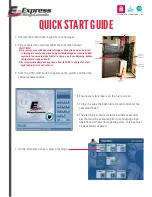
v3
8
Winton WSB
3. OPERATING ADVICE (Continued)
Safety:
Ensure tractor and machine is stopped & keys out of ignition before set
-
up/maintenance.
Stones and Obstructions
Always remove any obstructions, stones or other objects which could hit or become entangled in the
blades. If you have not cultivated the land before walk over the land and look out for any visible
objects and also rake over the land to identify any non
-
visible obstructions.
The rotary tiller is not generally suitable for work on very stony soil. A few small stones are usually
tolerated and will create no difficulties. On the other hand, working on excessively stony soils can
damage the blades and the machine itself. Such use will also void the guarantee.
Stone Size and Quantity
The machine buries stones in limited quantities and only stones which fall within the size limits
indicated. To ensure the best performance, the stones must not be larger than half the work depth
(e.g. for a job that is 10 cm deep, stones of up to 5 cm can be buried) and a large quantity of stones of
this size should not be in the soil. The optimum working condition is when the quantity of stones does
not exceed 15
%
of the volume of earth being worked.
If there are any stones which are larger than the recommendations, they must be removed before
starting work. If not, they could catch on the rotor and damage the machine. If there is an excessive
quantity of stones on the ground (even if they are smaller than the advised size), the quality of the
work could be compromised as it will not be possible to bury all of them.
Ground Conditions & Working on Gradients
Always avoid working on sloping surfaces if possible. If you chose to work on a gradient always take
care, it is preferable to work upwards or downwards rather than across the gradient to minimise the
risk of overturning.
Always check and comply with the tractor manufacturer’s instructions, particularly in relation to the
maximum gradient for working. When working on slopes the working speed should always be reduced,
gradually varying the speed and direction of the vehicle when manoeuvring.
Never operate on wet, slippery grass or soil or where the tyres are struggling to grip. If this is
unavoidable, always work at a low speed and take care.











































